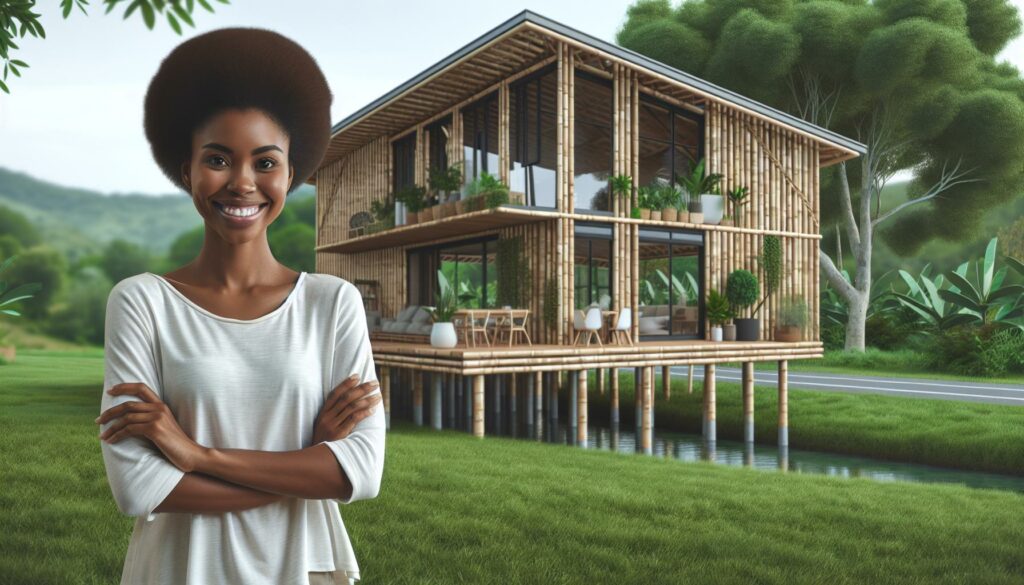Bamboo house:hfmpr0ktfwi= bamboo architecture is gaining momentum as a sustainable alternative in modern design. I’ve always been fascinated by how this versatile plant transforms into stunning structures that are both eco-friendly and aesthetically pleasing. With its rapid growth and strength, bamboo not only supports innovative designs but also minimizes environmental impact.
In my exploration of bamboo houses, I’ve discovered a perfect blend of tradition and modernity. These homes showcase the beauty of natural materials while embracing contemporary living. As I dive deeper into this topic, I’ll share insights into the benefits of bamboo architecture and its potential to revolutionize the way we think about sustainable living.
Key Takeaways
- Sustainability: Bamboo is a highly renewable resource that grows rapidly, requires minimal water, and absorbs significant carbon dioxide, making it an environmentally friendly building material.
- Cost-Effectiveness: Bamboo construction reduces costs by approximately 20-30% compared to traditional materials, due to lower material prices and reduced labor time.
- Design Versatility: Bamboo’s lightweight and flexible properties allow for innovative architectural designs, combining both aesthetic appeal and structural integrity.
- Community Engagement: Successful bamboo projects often involve local craftsmanship, promoting economic growth and cultural pride within communities.
- Resilience: Bamboo structures exhibit excellent resistance to natural disasters, absorbing and dissipating energy from storms and earthquakes.
- Challenges and Solutions: Addressing issues such as moisture susceptibility, pest infestation, and regulatory challenges through treatment and training can enhance the viability of bamboo as a sustainable construction option.
Bamboo House:hfmpr0ktfwi= Bamboo Architecture
Bamboo house:hfmpr0ktfwi= bamboo architecture utilizes bamboo, a renewable resource, for construction. Its lightweight nature makes bamboo ideal for various architectural designs. Bamboo structures showcase versatility, ranging from simple homes to complex buildings. Architects increasingly favor bamboo for innovative projects due to its strength and flexibility.
Bamboo possesses natural resistance to pests and environmental conditions, reducing maintenance costs. The use of bamboo also significantly lowers carbon footprints, making it a sustainable building material. Bamboo’s rapid growth cycle allows for quicker replenishment compared to traditional timber.
Incorporating bamboo into architecture promotes sustainability and aesthetic appeal. Many architects blend traditional methods with modern techniques for unique designs that emphasize open spaces and natural light. Bamboo architecture stimulates local economies by supporting craftsmanship and sustainable practices.
The following benefits highlight the significance of bamboo in architecture:
- Sustainability: Bamboo is biodegradable and requires minimal energy for processing.
- Cost-effectiveness: Lower material costs and reduced labor times contribute to economic efficiency.
- Aesthetic Value: Natural textures and colors of bamboo enhance the visual appeal of structures.
- Carbon Sequestration: Bamboo absorbs carbon dioxide, helping combat climate change.
Bamboo architecture exemplifies a forward-thinking approach to modern design, showing its potential to redefine sustainable living. As interest grows, architects continue to explore innovative ways to integrate bamboo into contemporary architectural practices.
Advantages of Bamboo House:hfmpr0ktfwi= Bamboo Architecture
Bamboo house:hfmpr0ktfwi= bamboo architecture offer numerous advantages, particularly in sustainability and cost-effectiveness. These factors make bamboo a compelling choice for modern architecture.
Sustainability
Bamboo is a highly sustainable material. It grows rapidly, averaging 3 to 5 feet per day, and reaches maturity in just 3 to 5 years, compared to decades for traditional timber. Its cultivation requires minimal water and no pesticides, leading to less environmental strain. Bamboo also absorbs more carbon dioxide during growth than most trees, acting as a natural carbon sink. Utilizing bamboo for construction reduces deforestation and promotes biodiversity in ecosystems. By choosing bamboo, we support sustainable building practices while preserving the planet’s natural resources.
Cost-Effectiveness
Bamboo’s cost-effectiveness stems from its availability and low maintenance requirements. It often costs 20-30% less than conventional building materials. Its lightweight structure reduces transportation costs and speeds up construction time, which can lead to further savings. Bamboo’s natural resistance to pests and decay means lower long-term maintenance costs, making it a prudent investment. As demand for eco-friendly housing rises, using bamboo can result in significant financial benefits over time.
Design Elements of Bamboo Houses
Bamboo houses incorporate unique design elements that enhance both function and visual appeal. The use of bamboo provides unmatched structural and aesthetic qualities, making these homes truly distinctive.
Structural Features
Structural elements of bamboo houses include strong, lightweight frameworks. Bamboo’s inherent flexibility enables it to withstand strong winds and seismic activities, ensuring durability. I often notice that architects leverage bamboo’s tubular shape, which distributes weight efficiently and adds to stability. Elevated designs with bamboo allow for impressive ventilation and natural airflow, promoting comfort in tropical climates. Additionally, connections between bamboo segments are typically secured with natural fibers or specialized fasteners, emphasizing the overall sustainability of the construction process.
Aesthetic Considerations
Aesthetic considerations in bamboo architecture reflect a harmonious balance between natural beauty and modern living. I admire the organic textures and colors of bamboo, which create warm and inviting spaces. Architects often showcase bamboo’s versatility by integrating it into both traditional and contemporary designs. Curved shapes and open layouts enhance the visual flow and connection with the surrounding landscape. The use of bamboo in decorative elements, such as furniture and fixtures, adds unique character and complements the home’s overall design theme. Emphasizing large windows and open spaces enhances the natural light that floods through, further enhancing the aesthetic appeal of bamboo houses.
Case Studies of Bamboo Houses
Bamboo houses serve as exemplary models of sustainable architecture. These structures highlight innovative designs and the practical benefits of using bamboo as a primary building material.
Notable Projects
- The Green School, Bali
The Green School in Bali demonstrates an immersive educational environment built entirely from bamboo. This school, designed by architect John Hardy, features open-air classrooms and large community spaces. The structure emphasizes natural ventilation and utilizes bamboo’s sustainability principles, showcasing the material’s unique beauty. - Mikado House, Japan
Mikado House in Japan integrates traditional Japanese design with modern architecture by using bamboo as the primary material. Architect Kengo Kuma emphasizes eco-conscious living through this project’s innovative use of bamboo as a structural element, which adapts to local climate conditions while ensuring a harmonious connection with nature. - Bamboo House, Vietnam
Located in Vietnam, Bamboo House employs local artisans to craft a fully sustainable living space. Designed by Vo Trong Nghia, this house showcases intricate bamboo joinery and practical use of space. The house’s elevated design enables effective drainage and natural cooling, reducing reliance on artificial climate control. - The Bamboo Bridge, Thailand
The Bamboo Bridge in Thailand serves as both a functional structure and a tourist attraction. Designed for pedestrians, it highlights bamboo’s strength and flexibility while fostering local craftsmanship. The project serves as a cultural symbol, promoting sustainable tourism through eco-friendly materials and construction methods.
- Sustainability is Central
Bamboo’s rapid growth and minimal resource requirements make it a sustainable choice for construction. Each project illustrates how using bamboo results in lower carbon footprints while also supporting local ecosystems. - Design Flexibility
Bamboo’s lightweight and versatile characteristics enable creative architectural expressions. Each case study demonstrates the dynamic possibilities bamboo offers for both modern and traditional designs. - Community Involvement Matters
Successful projects often engage local craftsmen and communities, fostering skills development and economic growth. This participation boosts community pride and encourages the integration of traditional techniques into contemporary projects. - Resilience Against Natural Events
Many bamboo structures showcase exceptional resilience against earthquakes and storms. The flexibility of bamboo enables it to absorb and dissipate energy, making it suitable for regions prone to natural disasters.
Challenges and Solutions in Bamboo Construction
Bamboo construction faces specific challenges that architects and builders encounter. Understanding these obstacles enhances the effectiveness of bamboo as a sustainable building material.
- Moisture Susceptibility
Bamboo’s natural composition makes it prone to moisture absorption. Exposure can lead to mold and decay. Using protective treatments can seal bamboo, preventing moisture-related issues. Ventilated designs reduce humidity levels inside structures. - Pest Infestation
Bamboo’s organic nature attracts pests, which can compromise structural integrity. Implementing treatments like boron or preserving agents deter pests. Regular inspections ensure early detection and management of infestations. - Quality Variation
Bamboo quality varies based on species and harvesting techniques. Inconsistent material can affect structural performance. Sourcing bamboo from reputable suppliers ensures quality control and uniformity. Standardized grading systems help assess the suitability of bamboo for construction. - Limited Technical Knowledge
Many builders and architects lack experience with bamboo design and construction methods. Increasing training programs and workshops improves technical expertise. Engaging local craftsmen with traditional skills also enhances construction practices. - Regulatory Challenges
Building codes often don’t account for bamboo as a primary material. Advocating for updated regulations can promote acceptance of bamboo construction. Collaborating with local authorities ensures compliance while demonstrating safety and performance. - Fire Resistance
Bamboo is combustible and poses fire hazards. Treatments with fire-retardant chemicals can enhance fire resistance. Incorporating firebreaks and designing with non-combustible materials helps mitigate risks. - Thermal Performance
Bamboo may not insulate as effectively as traditional materials. Incorporating insulation systems, such as straw bales or recycled materials, improves thermal performance. Strategic orientation and shading devices can optimize indoor climate control.
Addressing these challenges through innovative solutions ensures bamboo’s viability as a sustainable construction method. The continued evolution of bamboo architecture ultimately enables designers and builders to realize its full potential.
Movement Towards Sustainable Living
Bamboo architecture is more than just a trend; it’s a movement towards sustainable living. I’m inspired by how this remarkable material can reshape our built environment while preserving the planet. The blend of beauty and functionality in bamboo houses captivates me, showcasing the potential for eco-friendly design that doesn’t compromise on aesthetics.
As architects continue to innovate with bamboo, I’m excited to see how this versatile material will redefine our expectations of modern living. Embracing bamboo isn’t just about building; it’s about creating a future where sustainability and style coexist harmoniously. The journey of bamboo architecture is just beginning, and I can’t wait to explore what lies ahead.

